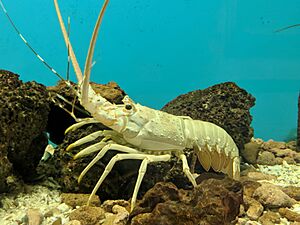Panulirus homarus facts for kids
Quick facts for kids Panulirus homarus |
|
|---|---|
 |
|
| Conservation status | |
| Scientific classification | |
| Genus: |
Panulirus
|
| Species: |
homarus
|
| Subspecies | |
|
|
| Synonyms | |
|
|
The Panulirus homarus is a type of spiny lobster. It lives in the warm waters of the Indian Ocean and Pacific Ocean. You can often find it in shallow areas near the coast. This lobster likes to eat brown mussels.
Most Panulirus homarus lobsters grow to be about 20 to 25 centimeters long. That's about the length of a standard ruler! While many are dark green, some can be red. People catch these lobsters for food in small fisheries.
Contents
Where It Lives
The Panulirus homarus lobster is found across a huge area. This includes the Indo-West Pacific region. You can find it from East Africa all the way along the Indian Ocean coast. It also lives near the Malay Archipelago. From there, its home stretches along the Pacific Ocean coasts. This goes north to Japan and south to Australia and New Caledonia.
These lobsters prefer shallow water. They usually live in water that is only 1 to 5 meters deep. They often hide among rocks where ocean waves break. Sometimes, they can be found in deeper water, up to 90 meters down. They can also live in cloudy water.
What It Looks Like
A Panulirus homarus lobster can grow up to 31 centimeters long. Its main body shell, called the carapace, can be about 12 centimeters long. But most of them are usually around 20 to 25 centimeters long.
These lobsters come in different colors. Most of them are a dark green color. They have very small bumps on their belly segments. Other lobsters of this species are red. These red ones have much bigger bumps on their belly segments. The green type is sometimes called the microsculpta form. The red type is known as the megasculpta form.
Different Types (Subspecies)
Scientists recognize three main types, or subspecies, of Panulirus homarus. These types are separated by their color and the bumps on their bodies. They are also found in different places.
The original description of this lobster was based on the green microsculpta form. So, this type is called P. h. homarus. You can find it throughout the entire area where the species lives.
The red megasculpta form is found in two separate places. Each of these is considered a different subspecies:
- P. h. megasculpta lives in southern Arabia and near Socotra.
- P. h. rubellus lives off the coasts of Madagascar and Southern Africa.
How It Lives
Panulirus homarus lobsters are active at night. They also like to live in groups. Their main food source is the brown mussel called Perna perna.
In South Africa, these lobsters are an important food for the Cape clawless otter.
Lobster Fishing
For a long time, P. homarus was only caught in small amounts in South Africa. But in 1969, a company started to catch more of them.
This lobster is also very important for fishing in Tamil Nadu and Kerala in India. However, in East Africa, it's not as common. For example, off the coast of Somalia, about 120 tons are caught each year. People also catch these lobsters in the Philippines, Taiwan, and Thailand.
In Vietnam, young lobsters caught in the wild are raised in special farms. In Australia, new ways to raise lobsters from eggs are almost ready for use by businesses.
About Its Name
The Panulirus homarus was first named Cancer homarus in 1758. This was done by Carl Linnaeus in his famous book Systema Naturae. This book is where many animal names officially began. The first description was very short. It said the lobster had a spiky chest and no claws. It was found in the "Asian Sea."
The first picture of this lobster was in a book from 1705. This picture is now kept in the Tropenmuseum in Amsterdam. Even though Linnaeus's description was vague, the picture shows the lobster was from Ambon, Indonesia.


